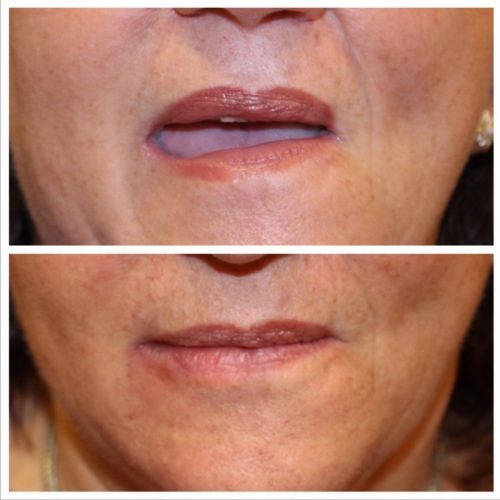While facial fillers are widely known as cosmetic products, they are offered at Mass Eye and Ear to help treat patients with facial paralysis. Focus spoke with Linda N. Lee, MD, a physician and surgeon in the Division of Facial Plastic and Reconstructive Surgery at Mass Eye and Ear, to learn more.
Facial paralysis can lead to loss of function
A person with facial paralysis is unable to move muscles on one or both sides of the face, which can greatly affect daily life.
Bell’s palsy is the most common cause of facial paralysis, and trauma, stroke or a tumor can also result in this condition. Symptoms can include oral incompetence, or the inability to keep the lips together in a resting state, which can result in drooling while eating and drinking; difficulty making facial expressions, such as smiling or frowning; facial weakness and muscle twitches. Oftentimes, patients also have issues saying words that include “P” and other letters that require closed-lip motion. While some recover without treatment in cases of Bell’s palsy, others may experience more permanent effects.
“There are surgical options to help restore a smile, but sometimes patients with facial nerve weakness have a smaller problem. This includes a distinct area of volume loss from not using the muscle for a long period of time – called disuse atrophy,” Dr. Linda Lee, a member of the Mass Eye and Ear Cosmetic and Facial Plastic Surgery Center, described to Focus. “For these select patients, facial filler may be an easy in-office treatment to help improve function and volume that has been lost.”
Non-surgical option for facial paralysis
Before facial fillers were used for patients with facial paralysis, the main options were surgeries to transfer nerves and muscles to affected areas of the face, and a procedure called autologous fat transfer, in which fat is taken from one part of the body and surgically placed in the face. These procedures are well-studied and can be highly effective.
Some patients, however, prefer a non-surgical treatment option that is more temporary, and that’s where fillers can be preferable.
There are many reasons that facial fillers are a good treatment option for facial paralysis patients, according to Dr. Lee. They do not interfere with nerve recovery, and can be used to temporarily help patients with speech or eating while waiting to see if they will achieve full recovery. Fillers also last a short while and are reversible, generally one to two years depending on the area treated before they dissolve. No anesthesia is required, and the treatment is performed in the office. Since the patient is awake, the physician is able to test different speaking movements in real-time as the filler is injected. It is often viewed as a good trial before considering surgical grafting as a more permanent option. Typically, the process consists of three appointments: a pre-evaluation and consultation, followed by a short visit for treatment, and then a virtual follow-up two weeks later.
Dr. Lee explained that with any facial paralysis treatment, the goal is to “move the needle towards symmetry” for patients. For some, a single treatment of filler can also improve their function, especially speech, as well as their ability to eat and drink.
Treatments may offer emotional benefits

Dr. Lee recently spoke with CNN about using cosmetic fillers to treat a reconstructive problem – and the overlap between functional and cosmetic surgery. The piece highlighted the positive mental health aspect of restoring one’s appearance after functional problems such as facial paralysis, car accidents, or even severe acne scars. The article also discussed two studies led by Dr. Lee, which found that facial nerve patients who received filler injections were less likely to avoid photographs, less worried about people thinking they had a stroke and felt more personal confidence.
Suzanne Nevins, a 67-year-old Mass Eye and Ear patient who has paralysis on the right side of her face that affects her speech and ability to eat foods like soup, shared her experience with fillers with CNN:
“I could cry, because I could not believe how much getting that lower lip firmer helped,” she said. “I ate better, I spoke better and I was much more comfortable. It’s physical health, but it’s also mental.”
Clinicians hope more study may lead to universal insurance coverage
Dr. Lee and her colleagues began to study the effects of facial fillers for functional use in 2018. In the study, participants were prospectively enrolled and followed after filler treatment. The researchers found that just a single treatment of filler greatly improved psychosocial health for patients with facial paralysis. According to Dr. Lee, this was the first study to look at psychosocial wellbeing and functional filler for facial paralysis.
“So much of what we do involves improving quality of life and helping patients build confidence,” added Dr. Lee. “It can be hard to objectively measure the impact of facial paralysis for a patient because facial asymmetry can manifest so differently in each patient; the issues can be primarily functional disturbing speech and eating, but the mental health effect cannot be overlooked. For the right candidate, facial fillers can be life-changing.”
Dr. Lee and the team are working on additional studies and are hopeful that functional use of filler for facial paralysis will be universally covered by insurance in the near future. Currently, HIV lipodystrophy, a condition where fat and muscle in the face is lost as a result of the virus, is one of the only medical indications where facial fillers are routinely covered by insurance due to the passage of a 2009 law.
“Treating facial paralysis is reconstructive, not cosmetic,” said Dr. Lee. “It is not indicated for every patient, but we are hopeful that with more long-term data, we will be able to understand which patients will benefit the most from this treatment option and be able to offer it with insurance coverage.”
For more information on any treatment for facial paralysis, visit the Facial Nerve Center. Mass Eye and Ear also offers fillers and other procedures for cosmetic purposes, visit our Cosmetic Surgery Center for more information.


I have Bells Palsy and I would like artificial lips